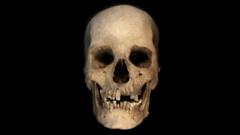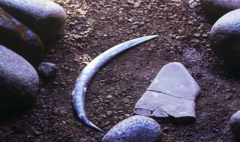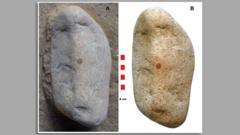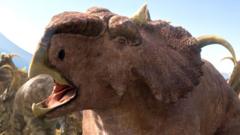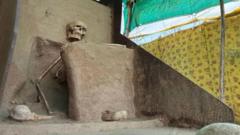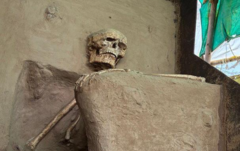The find includes remains of 129 individuals, showcasing artifacts that provide clues to Roman-Germanic confrontations during the Empire's expansion.
**Ancient Battle Site Unearthed: Roman Mass Grave Discovered Beneath Vienna Soccer Field**

**Ancient Battle Site Unearthed: Roman Mass Grave Discovered Beneath Vienna Soccer Field**
Archaeologists uncover a significant mass grave of Roman soldiers, revealing insights about a historic military conflict nearly 2,000 years ago.
Recent excavations beneath a soccer field in Vienna's Simmering district have revealed a mass grave containing the remains of at least 129 people, believed to be Roman soldiers from a turbulent era of the Empire's history. This astonishing find, made last October during renovations, gives a glimpse into the struggle between Roman forces and Germanic tribes nearly 2,000 years ago.
The discovery was facilitated by a construction team that inadvertently unearthed the grave, prompting an investigation by experts from the Vienna Museum. They have characterized the find as resulting from a “catastrophic” military event, indicating a potential defeat of Roman troops who may have fled the scene in haste, leaving their fallen behind.
Radiocarbon dating of the skeletal remains suggests they date back to between A.D. 80 and 234, during which time significant emperors such as Domitian and Trajan were at the helm of the Roman Empire, often engaging in battles near this area. Alongside the bones, archaeologists have uncovered a variety of associated artifacts, including an iron dagger, lance points, scale armor, and a cheek piece from a Roman helmet, which help to affirm the context and timeline of the burial site.
One particularly revealing find was the discovery of shoe nails attributed to caligae, the distinctive military sandals worn by Roman soldiers. According to Michaela Binder, the lead anthropologist on the excavation, such discoveries of unburned human remains from this period are exceedingly rare. “Prior to the third century A.D., Romans predominantly practiced cremation, making this an exceptional opportunity for researchers to delve into the lives of individuals from the first century,” Binder noted.
Overall, the excavation has not only shed light on Roman military practices and conflicts but also offers invaluable data for historians aiming to better understand the dynamics of life and mortality in the context of ancient Rome. The analysis will likely reveal further details about the socio-political environment of that era, enriching the historical narrative of the Roman Empire's encounters with its neighboring tribes.
The discovery was facilitated by a construction team that inadvertently unearthed the grave, prompting an investigation by experts from the Vienna Museum. They have characterized the find as resulting from a “catastrophic” military event, indicating a potential defeat of Roman troops who may have fled the scene in haste, leaving their fallen behind.
Radiocarbon dating of the skeletal remains suggests they date back to between A.D. 80 and 234, during which time significant emperors such as Domitian and Trajan were at the helm of the Roman Empire, often engaging in battles near this area. Alongside the bones, archaeologists have uncovered a variety of associated artifacts, including an iron dagger, lance points, scale armor, and a cheek piece from a Roman helmet, which help to affirm the context and timeline of the burial site.
One particularly revealing find was the discovery of shoe nails attributed to caligae, the distinctive military sandals worn by Roman soldiers. According to Michaela Binder, the lead anthropologist on the excavation, such discoveries of unburned human remains from this period are exceedingly rare. “Prior to the third century A.D., Romans predominantly practiced cremation, making this an exceptional opportunity for researchers to delve into the lives of individuals from the first century,” Binder noted.
Overall, the excavation has not only shed light on Roman military practices and conflicts but also offers invaluable data for historians aiming to better understand the dynamics of life and mortality in the context of ancient Rome. The analysis will likely reveal further details about the socio-political environment of that era, enriching the historical narrative of the Roman Empire's encounters with its neighboring tribes.



